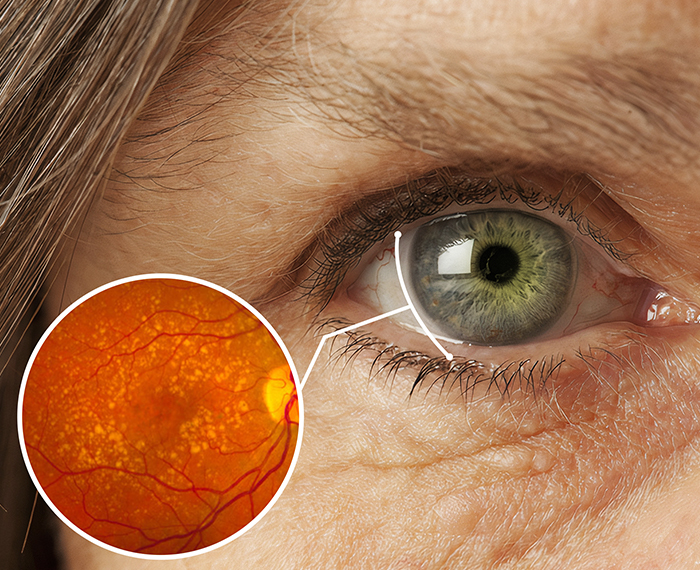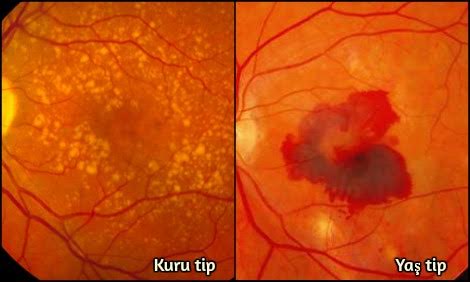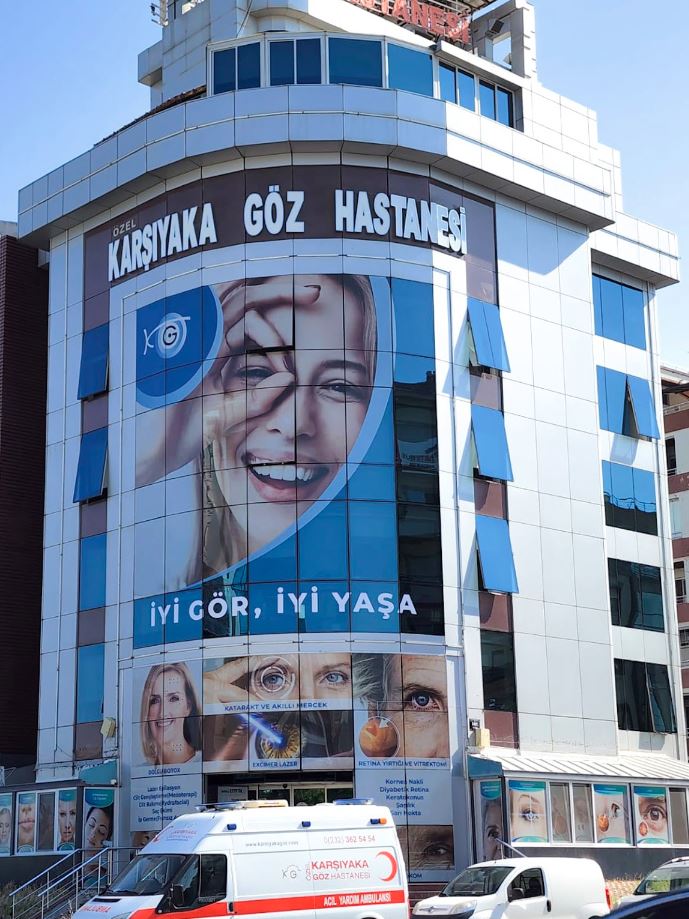
Yellow Spot Disease (Macular Degeneration)
What is age-related macular degeneration (yellow spot disease)?
Age-related macular degeneration known as ‘yellow spot disease’ in the community; It is an eye disease that causes severe loss of central (central) vision. Central vision directly helps the person to see the front. For example, reading, watching television.
If central vision deteriorates, the following symptoms occur:
* Difficulty in reading written and printed texts
* Difficulty recognizing people’s faces
* Colors appear pale
AMD is usually seen in both eyes, but the rate of progression from eye to eye is variable.
* Difficulty in reading written and printed texts
* Difficulty recognizing people’s faces
* Colors appear pale
AMD is usually seen in both eyes, but the rate of progression from eye to eye is variable.

What is AMD?
AMD is the center of the eye responsible for central vision called Macula in the region known as the Yellow Dot occurs as a result of not functioning. Although it is not known exactly what caused the deterioration of the yellow spot; aging, smoking, inappropriate diet, and family history of AMD may increase the risk.
AMD does not affect environmental vision, although patients’ central vision is impaired, but their vision is intact, so complete blindness does not occur.
AMD does not affect environmental vision, although patients’ central vision is impaired, but their vision is intact, so complete blindness does not occur.
AMD Types
DRY TYPE AMD: Some minerals and vitamins in the diet due to deficiency of the yellow dots caused by damage to the visual cells and develops as a result of the yellow point of the metabolic residues of visual cells called Druzen accumulate. Dry type is the most common (90%) and less dangerous type of AMD. Vision decreases over the years. However, one in 10 patients with dry AMD develops Wet Type AMD over the years, while wet type AMD is the more severe type that causes loss of central vision.
AGE TYPE AMD: Wet type Amd is caused by the development of vessels that grow below the yellow dot, leak in time and cause bleeding. This bleeding and leakage in the veins damages the visual cells in the yellow spot, and in time, scar tissue or scar tissue develops at the yellow spot and disrupts the central vision. The wet type is more severe than the dry type and if left untreated, the patient may lose sight in days. Although treated with wet-type intraocular drug injections, a loss of central vision may occur with scarring at the yellow spot over time.
In both types, the patient loses sight of the center. It becomes difficult to read books, distinguish phone numbers or money, recognize the person he is looking at, watch television.
AGE TYPE AMD: Wet type Amd is caused by the development of vessels that grow below the yellow dot, leak in time and cause bleeding. This bleeding and leakage in the veins damages the visual cells in the yellow spot, and in time, scar tissue or scar tissue develops at the yellow spot and disrupts the central vision. The wet type is more severe than the dry type and if left untreated, the patient may lose sight in days. Although treated with wet-type intraocular drug injections, a loss of central vision may occur with scarring at the yellow spot over time.
In both types, the patient loses sight of the center. It becomes difficult to read books, distinguish phone numbers or money, recognize the person he is looking at, watch television.
When Should Apply To a Doctor ?
When blurring begins at the center of vision, a doctor should be consulted, especially when straight and uniform lines appear to be curved or broken.
Who is Affected ?
AMD is one of the most important causes of vision loss in the population over 55 years of age. It is generally more common in women. It is more common in Caucasian race than in other ethnic groups. As the name suggests, advanced age is the most important risk factor. It occurs in about one in ten people in the 55-65 age group. It occurs in one out of two people over 85 years of age.
TO REDUCE AMD RISK:
- Smokers should stop smoking
- Alcohol intake should be restricted
- Red meat should be restricted in diet and green leafy vegetables should be weighted and should be fed rich in antioxidant substances,
- Disease should be kept under control in hypertension and diabetic patients,
- weight gain should be avoided.
Are there special glasses for yellow spot disease?
With special glasses called as auxiliary vision instruments, magnifying effect can be created to increase the vision.
These glasses are called telescopic glasses. It functions as a kind of binoculars. With telescopic glasses, it is possible to see the patient far and close. However, it is very difficult for the patients to adapt to these glasses. The vision areas of these glasses are very narrow and the patient sees as if looking through the keyhole. The ratio of patients to adapt to these glasses is 10 percent. Although the central vision is strengthened, it is not possible to move and walk with the Glasses since the peripheral vision is eliminated. However, in the yellow spot disease, the patient cannot see the place where he is looking, but he can see the surrounding area. But when wearing binoculars glasses, environmental vision that makes everyday life easier is eliminated.
These glasses are called telescopic glasses. It functions as a kind of binoculars. With telescopic glasses, it is possible to see the patient far and close. However, it is very difficult for the patients to adapt to these glasses. The vision areas of these glasses are very narrow and the patient sees as if looking through the keyhole. The ratio of patients to adapt to these glasses is 10 percent. Although the central vision is strengthened, it is not possible to move and walk with the Glasses since the peripheral vision is eliminated. However, in the yellow spot disease, the patient cannot see the place where he is looking, but he can see the surrounding area. But when wearing binoculars glasses, environmental vision that makes everyday life easier is eliminated.
Intraocular lenses specific to yellow spot disease?
In some cases of delayed treatment and refractory treatment, loss of central vision is inevitable. Unfortunately, there is no other treatment option for these patients. This is usually a condition that affects both eyes. It is very difficult for the patient to maintain his / her daily life in a situation where both eyes have decreased vision.
These lenses are specially developed for AMD, aiming to increase central vision. At AMD, there is a loss of central vision due to damage to the visual cells in the yellow spot. These lenses are inspired by the Hubble Telescope and are known as telescopic intraocular lenses. The advantage is that there is no deprivation of environmental vision in telescopic glasses. Both the central and environmental vision of the patient increases.
These lenses are specially developed for AMD, aiming to increase central vision. At AMD, there is a loss of central vision due to damage to the visual cells in the yellow spot. These lenses are inspired by the Hubble Telescope and are known as telescopic intraocular lenses. The advantage is that there is no deprivation of environmental vision in telescopic glasses. Both the central and environmental vision of the patient increases.
How Do These Lens Work ?
These lenses are inserted into the eye through a very small incision, as in the case of surgery. It enlarges the existing image that enters the eye with a telescopic effect and reflects the image to a healthy area outside the damaged area of the yellow dot with a prismatic effect. In other words, a new yellow spot is created for a patient.
With these lenses, patients regain their ability to drive, recognize people’s faces and read them.
With these lenses, patients regain their ability to drive, recognize people’s faces and read them.
How Do These Lens Work ?
These lenses are inserted into the eye through a very small incision, as in the case of surgery. It enlarges the existing image that enters the eye with a telescopic effect and reflects the image to a healthy area outside the damaged area of the yellow dot with a prismatic effect. In other words, a new yellow spot is created for a patient.
With these lenses, patients regain their ability to drive, recognize people’s faces and read them.
With these lenses, patients regain their ability to drive, recognize people’s faces and read them.
Who are these lenses suitable for?
These lenses can be used in the dry type and stabilized wet type forms of AMD, as well as in some hereditary retinal diseases such as Macular holes, Stargart and Best disease, in high myopia-related macular diseases and in diabetic retinopathies due to diabetes. Some of these lenses can be used in patients who have undergone cataract surgery as well as in patients without cataract surgery. In some patients, yellow spot disease may develop years after cataract surgery. Nowadays, it is possible to increase central vision by placing a second telescopic lens on these patients.









